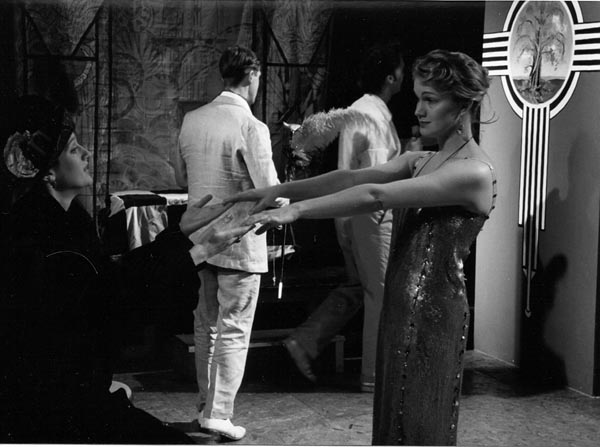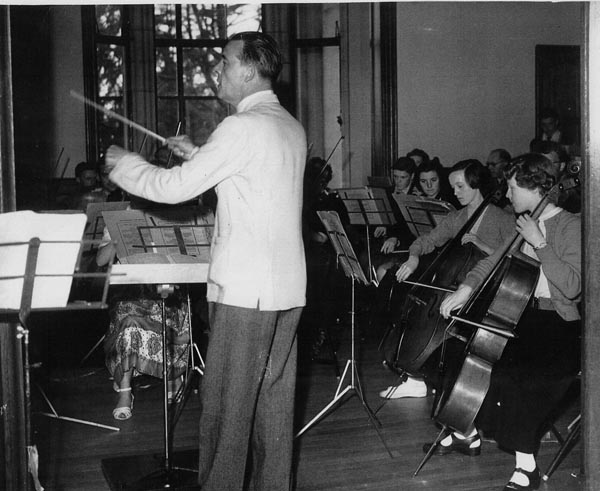The festive season and the holidays have again brought home to many of us just how much the arts can enhance our lives – let’s keep it that way!
The fight for work in Britain’s cultural industries
WORKERS, JAN 2012 ISSUE
No doubt many readers will have taken the opportunity over Christmas to visit a favourite museum, catch a favourite band or orchestra, take friends or family to a seasonal ballet or panto, be enlivened by jazz at a local pub. Even for the stay-at-homes there will have been the experience of some great character acting on radio or television.
Some will have felt compelled to join forces and put on their own community show or dance events. There’s no lack of enlivening inspiration around – from Brazilian to Bangra, from classical to ceilidh. The English Folk Dance and Song Society reports little let-up in the popularity of social dance and more is in evidence in dance classes and folk festivals from Shetland to Sidmouth.
Ours is also a singing nation: the harmonised sea shanties of the south coast, the Welsh Choirs, the Gaelic vocals of the Western Isles, the classical song tradition of the concert hall, the raw rap of the urban studio to mention but a few.
For others it’s the more reflective tasks of oils on canvas or poetry on paper. The brass, pipes and wind band movement continues to involve many tens of thousands - persisting long beyond their origins in mine, mill and other workplaces. Remember that great film ‘Brassed Off’? From nursery to older age (as demonstrated by Live Music Now), music and other arts have proven vital for educational development.
Behind the scenes
Yet we must recognise that behind this swirl of activities lies considerable teaching of a high order and professionalism that’s world class. Now it’s from these workers in the field that an epic appeal has gone out. They warn that a terminal decline to this whole picture could set in if erosion of such teaching and standards is not halted, if the debilitating or axing of key arts organisations is not resisted.

Modern British opera: dress rehearsal for “The Loving of Etain”, written by composer Eddie McGuire in collaboration with playwright Marianne Carey.
To flag up this danger, a campaign has been initiated by eight trade unions whose members are directly affected by the current undermining of our cultural life by a failing capitalism. It’s called “Lost Arts” and intends to defend the arts by first of all finding out exactly the extent of the attack and undermining.
A glance at the unions involved shows the really wide range of professional skills that provide the backbone to our culture. We have the Musicians’ Union, Equity (actors), BECTU (broadcasting, film, theatre and leisure), the NUJ (journalists), the Writers’ Guild and the large unions (Unite, PCS and Prospect) that have smaller sections working in the cultural field. An absence that will be rectified at a later date is Unison, which represents those working in museums and local government arts and heritage activities. Support is coming in from many other organisations such as the Book Trust, the British Archaeological Trust, the Scottish Artists Union, the Society of Playwrights, and so on.
In the seven months since the campaign started, £21 million has already been cut from arts funding in Britain – estimated to be a loss of over £42 million to the national economy. (Yes, through royalties, copyrights, sales and touring the arts are an earner and not a loser – a measure of the quality that has been built up).
Public funding is an established characteristic of arts in Britain. It is often forgotten that it was the third component – along with a National Health Service and a free education system for all – which our class fought for and achieved during and after World War Two. Administratively it took the form of the Arts Council of Great Britain. That model has been gradually divided, distorted and riddled with the privatising ethos.
Yet it is still this public funding that provides 53 per cent of backing for the cultural industries. Earned income (ticket sales, royalties, etc.) brings in 32 per cent. What is called “business investment” in arts has been falling 7 per cent each year since 2007, now standing at about 15 per cent of total arts funding. Instead of “arts for all” it may soon become “arts for those who can afford it” – if it is even there at all, with music and drama services shutting down and instrumental music teachers being made redundant.
Out of hundreds of examples of threats to the arts some stand out – like both Mendip District Council and Somerset County Council chopping their entire arts budgets; Yorkshire Libraries & Information closing its Music and Drama Collection and Service; closure of the University of East Anglia’s Music Department; Argyll & Bute Council selling off the superb outdoor, music and drama residential facility at Castle Toward (gifted to the nation, part of the death knell of such residential centres so beneficial to youth throughout Britain); a 50 per cent cut to the National Youth Orchestra of Scotland and its Jazz Orchestra; a £140,000 cut to the City of Birmingham Symphony Orchestra and resultant 3.2 per cent pay cut.
Fighting tactics
Often the dilemma is whether to suffer and live to fight another day or to cease working. The occupation or work-in is hardly applicable in most of these jobs – although the Musicians’ Union in its second year (as a forerunner to the Amalgamated Musicians’ Union) hit on some innovative tactics: an 1886 opera at Her Majesty’s Theatre London saw half the orchestra walk out after the first act, coordinating with stage-hands and carpenters who walked out after the second act. With worrying talk of a BBC review of its music budget (this is the biggest patron of British orchestras), the tactics of the Britain-wide Musicians’ Union strike of 1980 that saved the orchestras (though sadly not the Radio Orchestras and “Big Bands”) will have to be revisited.
“Instead of ‘arts for all’
it may soon become
‘arts for those who can afford it’...”
It was that year, 1980, that Musicians’ Union membership reached a peak of over 41,000. In the decline of general union numbers since then, the MU has managed to keep membership above 30,000 - but the present decline in arts funding is again beginning to bite. Union membership in the full time, fully contracted stage and theatre orchestras has proven very resilient. A vast array of other music tasks are represented by the union - from those playing in jazz or folk bands to the composer, conductor, instructor or DJ. This union has plugged “Keep Music Live” for decades – the phrase seems to have entered everyone’s vocabulary – and a long campaign against the punitive Licensing Laws seems to be coming to fruition now. This had imposed a draconian system of payments on even the smallest pub or venue that employed musicians in England and Wales. The musicians who play these venues can be the first to lose out as the traditional British pub culture is ruined by exploitation and bankruptcies.
Behind the very special British tradition of stagecraft, both live and recorded, lie the endeavours of Equity, the actors’ union. From stand-up to Shakespeare, to the opera chorus, it has been representing a perplexingly diverse industry since 1930. Through a focus on youth recruitment, its 36,000 members include 5000 students. The veteran actor Simon Callow points to the need for “strength in numbers in a complex industry, to improve and defend our position. Equity is a unifying factor, with its expert knowledge, speaking for actors and to actors – indispensable.”
And behind or often in front of the actors and singers there is BECTU, for those working in broadcasting, film, theatre and leisure crafts. 1991 saw the current formation of a union that can trace its origins back to 1890 and the Theatrical and Music Hall Operatives Union. It represents visual art crafts as well. However, there have also been efforts to create specialist unions for visual artists – a profession that has long been at the bottom of the ladder compared to all other art forms. One of the youngest trade unions is the 10-year-old Scottish Artists Union with 700 members, already gaining valuable experience through several high profile campaigns and collaboration with its counterparts in the rest of Britain.

Early advance: Britain’s National Youth Orchestra was set up in 1951.
Under the umbrella of the TUC (and STUC in Scotland) these unions co-ordinate their actions through the Federation of Entertainment Unions, which, together with the unions already mentioned, brings in the NUJ (the world’s largest journalists’ union with over 40,000 members, founded in 1907), Unite, the Writers’ Guild, the Society of Playwrights and the Professional Footballers Association (an interesting addition – coming to public notice for their “united British team” motion at the recent TUC). Founded in 1907, the PFA has 4,000 members in England and Wales, with the affiliated PFAS in Scotland. The federation of unions represents over 130,000 working in the cultural sector.
Fight back
The potential is there for a fight back, a vigorous defence. There is much that is unique about British culture created by those who work in it and those who listen and participate – from the pioneering visuals of Tate Modern, to the Royal Shakespeare Company, to our jazz and folk festivals, to our groundbreaking BBC Radio 3, envy of the world for the presentation of musical classics.
The vitality of our popular music can also be world leading. But it takes quality and effort, not just a cheap exploitative commercialism. The Beatles did it in the 1960s. Now the Tottenham-born vocalist Adele Adkins has matched their achievement, selling 12 million albums (titled “21”) worldwide in 2011 and with 3 million sold in Britain, the fastest selling ever. This helped reverse a general nosedive in album sales. (Legal downloads now account for 28 per cent of sales, with more efficient providers like iCloud and Spotify). Behind such success lies talent and teamwork - and arising out of the innovation and creativity outlined above.
Bringing back revenues to Britain is a major task carried out by the royalty collecting body the Performing Rights Society – a complex operation of licensing British owned copyrights in every country of the world for performances on TV, radio, internet, downloads, mobile phones, juke boxes or any other system. However, taking into account all sources, the British music industry has declined in value for the first time, down 4.8 per cent to £3.8 billion since 2009. Other sections of the creative industries such as film and animation, computer games (bringing back the symphony orchestra in a big way), and touring exhibitions and productions make an invaluable contribution.
All this and more is part of our legacy and our future that is undoubtedly worth fighting for! ■